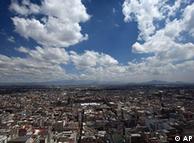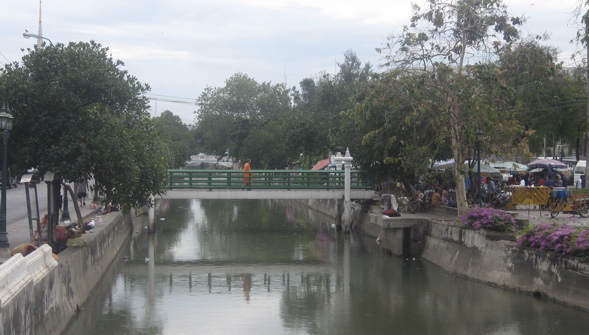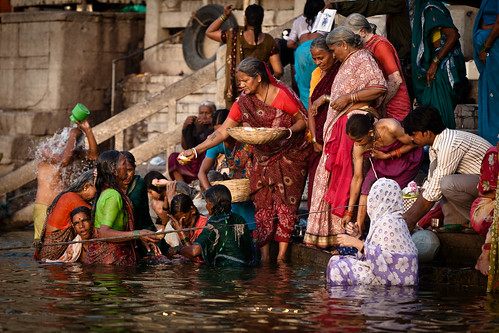Search Results for Tag: pollution
Breakdown: tackling climate change

Restrictions on driving and industry have helped to reduce emissions in Mexico City.
A lot of experts and analysts in the field of climate change say 2012 is a key year in the battle against global warming. Coming off the heels of Durban, many believe this will be the year to prove that the world is ready to take the next step forward – especially with significant parts of the Kyoto Protocol set to expire by the end of the year.
But to move forward, it’s important to know exactly where we stand! National Public Radio (NPR) in the United States recently featured a great breakdown on what the world’s political powers – and some of the biggest polluters – are doing to fight climate change in their respective countries. According to the article, the many of the biggest greenhouse gas emitters have already set goals on a national level to slash harmful emissions. Because there has been little progress on the international level, they have decided to move forward at home.
Those national goals include things like putting a stop to deforestation, investing more in clean, renewable energy sources and working with cap-and-trade policies to curb emissions. If you live in one of the listed countries, take a look at what your government is doing to fight climate change…and if not, let us know!
Take a deep breath in Laos
As a Journalist from Berlin, traffic in Asian cities is usually quite chaotic and for foreigners mostly an adventure. In Mumbai, India crossing a street could be a struggle of survival as one has to pass a mixture of motorbikes, cars, cows and rikshas. It’s the same in Bangkok,Thailand – just without cows. The worst about the traffic is not the chaos, it’s the pollution. The air people inhale is filled with dust, it sticks on the skin and it is also full of emissions polluting the air.
In Laos, the chaos has not arrived yet. The streets of its capital Vientiane are quiet and mostly empty. There are just a few bikes, scooters or motorbikes – sometimes a car. That keeps the CO2-emission low: 2010 Laos emitted a little more than 1,5 million tons, the United States for example 5,7 billion tons. Another reason is, that Laos has no heavy industry. But it would be a mistake to think of Laos as climate-friendly country where everyone could take a deep breath of clean air. Because it is not people’s climate-awareness that makes Laos climate friendly. The reason is the poverty of the country. The Human Development Index lists Laos as a one of the poorest countries in the world. People just can´t effort a car.
Bangkok´s dressed up – at first sight
 Thailand´s capital is gleaming. Not just because of the smiling people in the streets, but especially for the week-long birthday celebrations in honor of Bhumibol Adulyadej, the country’s king who turned 85 last Monday. A day before his birthday, the flood in Inner Bangkok was officially pronounced over. The city’s governor Sukhumbhand Paribatra declared that the situation in eleven districts had eased and that locals could return to their homes.
Thailand´s capital is gleaming. Not just because of the smiling people in the streets, but especially for the week-long birthday celebrations in honor of Bhumibol Adulyadej, the country’s king who turned 85 last Monday. A day before his birthday, the flood in Inner Bangkok was officially pronounced over. The city’s governor Sukhumbhand Paribatra declared that the situation in eleven districts had eased and that locals could return to their homes.
Since Monday the inhabitants are celebrating, the Grand Temple and the ministries are sparkling with fairy lights, and it appears that cleaning brigades are constantly out and about to sweep the streets – at least you can´t find any litter anywhere.
Well, at first sight. Only a few meters away from the celebrations you stumble into another side of Bangkok – its grungy one. The city’s canals, like this one near the Great Palace, are nothing to celebrate about. You literally have to hold your nose when the stinky grime – including dead fish, plastic bottles and sewage – passes you by. But it doesn’t stop there: The smelly mix continues on its way into the Mae Nam Chao Phraya, the river flowing through the city – and pollutes the environment.
Cleaning up the Ganges
The holiest of India’s rivers, the Ganges, is also among the world’s dirtiest. The 2,500-kilometer (1,500-mile) Ganges in India is choking under industrial effluents, farm pesticides and other untreated sewage. Several attempts to clean up the river have failed in the past.
Now, the Britain-based Thames River Restoration Trust is starting a new initiative. It plans to work with communities living along the river to restore ponds to treat waste water. Villagers will be helped to adopt eco-friendly agriculture and encouraged to save some of the world’s rarest freshwater wildlife such as the Ganges river turtle, the Ganges river dolphin and the critically-endangered Gharial crocodile.
As part of the project, scientists from India will visit Britain to learn how the trust helped restore the River Thames, from almost biologically dead in the 1950s to one of the cleanest urban rivers in the world.
What’s your plastic footprint?
With so much talk of climate change and carbon dioxide emissions nowadays, most people are familiar with a carbon footprint. But what about a plastic footprint?
An initiative in Hong Kong called The Plastic Disclosure Project plans to send out questionnaires to companies and institutions around the world asking them to assess, monitor and report their use of plastic. The aim is to get them to cut their plastic consumption as well as try to change the awareness and behavior of big users of plastic.
Environmentalists have long complained that plastic pollution has become a major threat to the world’s water bodies and the environment. If the plastic footprint becomes as widespread as its carbon counterpart, the project may just lead to a real clean up.











Feedback